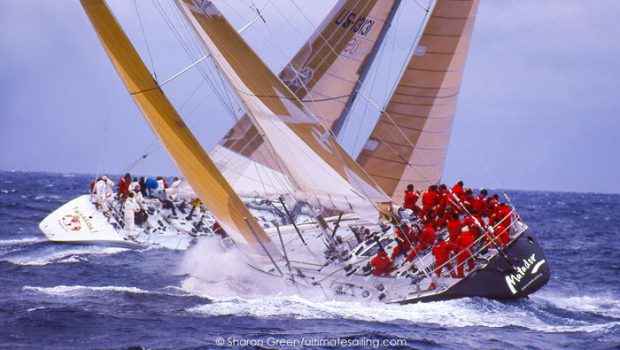Sailing’s Greatest Generation
Published on August 21st, 2022
Tucker Thompson, known widely through his work as a TV host, sailing commentator, and public speaker, shares his observations about the current state of sailing and what is needed for American sailing to get back on top.
“I used to race with Gary Jobson, Ken Legler, Moose McClintock, and Skip White” said the man next to me. His name was Jed, a burly sailor looking man in his sixties. I had just finished giving a presentation, and he and I were at the yacht club bar reminiscing about boats, events, and people in the sport.
“Our frostbite fleet still has a great deal of big names racing in it,” he said. “Steve Benjamin and Peter Isler were racing here with us just last weekend.”
It got me thinking of all the “big names” I had known or heard of in our sport throughout the US. Dennis Conner, Tom Whidden, Dave Perry, Tom Blackaller (RIP), Dave Dellenbaugh, Paul Cayard, Ken Read, Jerry Kirby, Jim Allsopp (RIP), Stu Argo, Dawn Riley, Mike Toppa, Buddy Melges, JJ Fetter, Butch Ulmer, John Kolius, Betsy Allison, Ed Baird… the list goes on.
My generation didn’t have even half of the names of great sailors who had become recognizable personalities in our sport – those that the generation below mine might talk about at the yacht club bar someday. And as far as I know, their generation has even less. Why was that? Where had all the great sailors gone? Then I realized that Jed and I had been talking about sailing’s greatest generation.
There are so many of them, legends, that all seemed to emerge from the same time period in the 80s and 90s. Perhaps not surprisingly their rise was directly proportional to the increase in popularity in our sport at the time. Sailing was huge in during this time.
It was a time when Maxi boats ruled, IOR flourished, and major regattas had hundreds of boats. There was still a direct connection to and trickle down from the America’s Cup. It had only just left Newport and Dennis Conner had just won it back. When else was a sailor on the cover of Time Magazine and sailing a big part of ESPN’s coverage?
I grew up reading about the sailors from this era. I dreamed to be one of them. I wanted to meet and sail with these legends, and eventually I did with many of them. And I distinctly remember the moment I felt I had finally arrived. I had joined their ranks as a professional sailor, had raced in many of the sport’s big events and with top programs, and sailed on an America’s Cup team.
I was sitting at Marmaduke’s, the famed sailing bar in Annapolis, telling one of these legends, a long-time crew member of the yacht Merrythought, that I felt I had finally earned a spot at the top of the sport only to realize that it wasn’t the same sport I had read about.
The boats were smaller, the regattas were too, and fewer still were the next generation of sailing heroes to step into the shoes of sailing’s greats. The larger-than-life image of top-level, competitive sailing I dreamt about didn’t seem to exist the way I thought it would when I finally became part of it.
This was in the late 90s, and what I didn’t realize then was that I was witnessing the beginning of sailing’s decline. It was a time when Mount Gay flowed freely and a Rolex was the ultimate status symbol of accomplishment in our sport. Dennis Conner was a household name and Gary Jobson told us all about it on television. Professional sailors traveled all over the world living adventurous lives that Walter Mitty would be jealous of.
I wanted to be part of it all and was for a while. But the Maxis and big IOR thoroughbreds gave way to smaller one design boats. Big regattas and long courses have been replaced by shorter events and windward-leewards.
Mount Gay now sits on the shelf with other brands, and many of the biggest regattas in our sport no longer begin with the name Rolex. The SORC is a distant memory, and the Key West Race Week we used to know, once the biggest sailing regatta in North America, is no longer!
Somehow through it all, the names of the legends are still there. We still talk about them at the bar and consider ourselves lucky when one of them shows up to sail in a local event. Their prowess in sailing still exists and while there will always be younger, smarter, and faster competitors on the racecourse, none garner the same recognition and reverence as these legends.
Perhaps this is a sign of what has happened to sailing, and to an extent the legends are partly to blame, through no fault of their own but as a byproduct of sailing’s success at the time. I call this the Dennis Conner affect.
To his credit, Dennis singlehandedly had more effect on commercializing sailing and professionalizing sailors than any other sailor in history. His Cup win in Australia revolutionized the sport of sailing – particularly in America.
Suddenly racing started to become much more professional. Owners began to hire the sport’s best talent and began training for events. Coaches were even hired. Sailmakers and boat builders thrived, and sponsors invested in sailing hoping to piggyback on what they saw in the America’s Cup coverage.
Top sailors became rock stars and young sailors like me looked up to them in awe. I realized that every one of the legends listed above and others like them from that era all have the exact same thing in common. They are all professionals in the sailing industry. They are the byproduct of the Dennis Conner affect.
The problem is that sailing as an industry could not continue to sustain that level of growth in the long run. Budgets skyrocketed. Owners became frustrated. Professionals pushed ever harder to win. The sport became too serious, too complicated, and less FUN!
As a result, the pendulum naturally has swung in the opposite direction. Boats have become smaller, regatta numbers have fallen, and there are less and less pros in the sport even at the America’s Cup level.
As an interesting side note, the original legends are still going. Not so much in mainstream sailing anymore, but in the very top-level events outside the US racing on boats like the J Class and Superyachts which many of them have jokingly referred to as the “Seniors Tour.”
Behind them is a void in sailing, particularly in the US. The industry is not what it used to be and struggles to find sponsors and larger scale media coverage. Events are smaller and fewer and in some cases gone altogether. The average age is rising and time constrained millennials, with shorter attention spans and smaller bank accounts, aren’t interested in big boats or big budgets.
Young sailors seeking to become professionals are finding less and less opportunities to do so in a shrinking industry. (A note to those that are: you’ve got to offer more than just being a good sailor such as coaching, making sails, or selling boats.) Not surprisingly though weeknight racing across America has actually grown because it’s easy, inexpensive, takes less time, and most of all is simply FUN!
Our sport can comeback. Sailing will rise again, albeit with a different look and feel. The next generation will find in sailing what they love about it and aspire to, and it will be different from the one we were used to. It will probably be on smaller faster boats, take less time, cost less, and the core focus will be on having FUN.
But to get back to the level of popularity and excitement sailing once enjoyed, and to attract more people – particularly young people – to the sport, sailing needs new heroes. It needs a new breed of legends to carry on the torch. A new group of champions that kids can look up to and say like I once did, “I want to do what those guys are doing!”
The Russell Coutts of New Zealand has been replaced by Peter Burling in the America’s Cup. Paul Elvstrom has been surpassed by Ben Ainslie in the Olympics. Here in the US we desperately need a Pete Burling or a Ben Ainslie.
We need the next generation of American sailing heroes to bring home a Gold Medal and bring back the America’s Cup. We need the next Dennis Conner to inspire not only a sport, but reignite national interest in sailing. (The average non-sailing American still thinks the America’s Cup is held in Australia!) It will also take time, effort, and a pathway to the top that young sailors can follow.
I am hopeful that we may see that pathway evolve and sailing’s next heroes emerge from New York Yacht Club’s American Magic America’s Cup program. The team, led by Terry Hutchinson and graciously backed by those investing in it, is perfectly poised to help save sailing in the US.
In the 2021 America’s Cup, the team partnered with US Sailing and Oakcliff Sailing Center among others to create a conduit for the next generation of elite sailors and help them get to the next Olympic or America’s Cup team. This time around there is a strong focus and investment in youth and women sailors.
Winning the Cup would be a bonus on top of an already strong program. They fell short last time but now have a very solid foundation from which to build upon, and they’ve set up a legacy program to build sailing in the long run, and for that I applaud them.
Who knows? Perhaps one day our kids will eventually be sitting at the yacht club bar talking about the legends they know of from American Magic. Perhaps programs like that will also help create a new industry from which professional sailors can follow their dreams and hope one day to step into the shoes of their legends.
Time will tell. In the meantime, to all the legends still out there inspiring the rest of us to keep sailing and keep sharing a love for our sport I want to say, “Thank You!” I hope the rest of us can follow your lead and make sailing great again in America! Good luck Terry. We’re counting on you!!!









 We’ll keep your information safe.
We’ll keep your information safe.